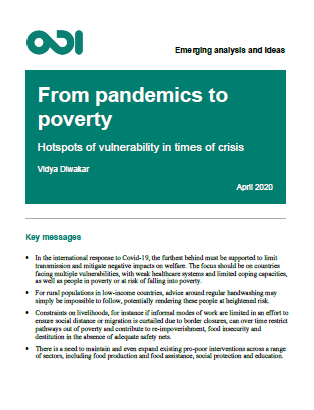Introduction
As governments rush to respond to coronavirus, there is an urgent need to ensure that the measures they take are sensitive to the needs of their poorest and most vulnerable people. Analysis of past disease outbreaks such as SARS and Ebola suggests that income poverty is an important factor in disease transmission (Fallah et al., 2015; Bucchianeri, 2010). Given the nature of Covid-19 and its transmission, containment and mitigation policies need to cover everyone, while also recognising that poorer people may be at greater risk of contracting Covid-19. Governments must also be sensitive to the short- and longer-term welfare impacts. Long-term poverty risks may be exacerbated through a vicious cycle of disease, destitution and death, whereby poverty contributes to disease transmission, and contagion fuels poverty. There may also be a trade-off between public health measures and the likely heavy economic and food security impacts. Poor and vulnerable people may not be able to cope with these second-order effects. This brief outlines countries, sub-national areas and populations in or near poverty that need to be explicitly prioritised in the response to coronavirus. The analysis focuses on developing countries with $1.90 poverty rates above 3% (based on a 2015–2018 average), unless stated otherwise. To help capture the multidimensional nature of poverty, we also include deprivations at the country and individual level, such as weak public health systems and coping capacities, high DALY counts and limited access to water, sanitation and health (WASH) services. Although the areas and populations highlighted are by no means an exhaustive sample, the brief is written with the aim of informing policy responses to consider the needs of groups that may otherwise be overlooked in government and international responses to Covid-19.
Key messages
• In the international response to Covid-19, the furthest behind must be supported to limit transmission and mitigate negative impacts on welfare. The focus should be on countries facing multiple vulnerabilities, with weak healthcare systems and limited coping capacities, as well as people in poverty or at risk of falling into poverty.
• For rural populations in low-income countries, advice around regular handwashing may simply be impossible to follow, potentially rendering these people at heightened risk.
• Constraints on livelihoods, for instance if informal modes of work are limited in an effort to ensure social distance or migration is curtailed due to border closures, can over time restrict pathways out of poverty and contribute to re-impoverishment, food insecurity and destitution in the absence of adequate safety nets.
• There is a need to maintain and even expand existing pro-poor interventions across a range of sectors, including food production and food assistance, social protection and education.
Author: Vidya Diwakar

